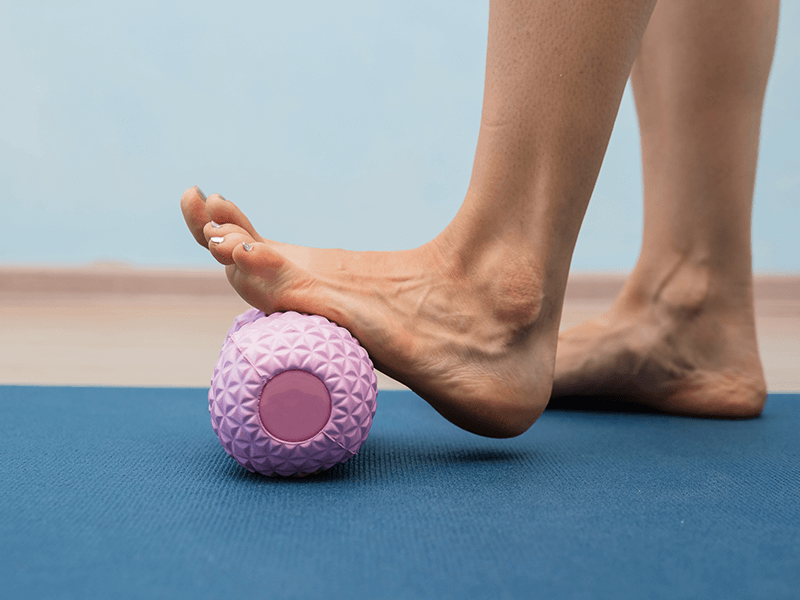Search
Find a Physician
Blog
Sep 4, 2023
Sesamoid bones are round bones located within a tendon. The most recognizable is the kneecap. However, there are small sesamoid bones at the base of the great toe. Together with the tendons, they control the movement of the big toe. When they get inflamed, the condition is called Sesamoiditis, and it can be excruciatingly painful and make even something as simple as walking incredibly painful.
The good thing is that this is a treatable condition and responds well to conservative treatment. Surgical intervention is highly unlikely and only used as a last resort (in the worst-case scenario). Even the necessity for corticosteroid treatment is unlikely. So, what does this conservative sesamoiditis treatment involve? Let’s check it out!
Generally speaking, there are a few factors that cause sesamoiditis.
You should wear proper footwear to avoid these, always warm up, and gradually build up your activity. Lower body weight will also put less pressure on your feet, reducing the likelihood of developing sesamoiditis.
Some people have genetic predispositions, so biomechanical issues and foot structure also play a role in this condition’s development.
The symptoms of sesamoiditis are pretty much what you would expect them to be.
One more thing worth mentioning is that the symptoms develop gradually. Ignoring the problem and continuously overusing this area will make it all worse.
Just remember that sesamoiditis isn’t the only thing causing the symptoms. Sesamoid fractures are also an option, and while the symptoms mentioned will be far more intense, many people mistakenly (by default) assume that it’s sesamoiditis.
So, what does sesamoiditis feel like? We’ve already listed pain as one of the potential conditions, but there are different types of pain. The pain coming from sesamoiditis is often described as a dull, persistent ache just beneath the big toe joint. While the steps are excruciatingly painful, the ache might occur while resting. Other than that, you might feel a throbbing or pulsating sensation from this area.
As mentioned, corticosteroids and surgery are only used as the last resort when treating sesamoiditis or forefoot pain. Instead, you’re advised to:
Remember that while this is happening, you must adjust your footwear. Make sure you find something with cushioning that will reduce the pressure on your sesamoid bones. Ideally, you would engage in complete rest, but since this is not an option, anything that will reduce the pressure on the affected area will help.
Generally speaking, even sesamoiditis taping can prove to be of help. Other than this, foot strapping and appropriate orthotics will make a significant difference.
When you decide to return to activities, you should ensure that the return is as gradual as possible.
Physical therapy is one of the most effective ways to treat sesamoiditis and reduce the likelihood of it occurring in the future. It usually consists of:
The idea is that by strengthening the surrounding muscles and improving foot mechanics, you’ll relieve the affected area and ensure that it’s under less pressure in the future.
The most important aspect of this physical therapy is that a professional will monitor your progress and modify the activities based on your current situation.
There are several exercises that will improve the strength and flexibility of the surrounding area, thus alleviating pain, improving your quality of life, and reducing the likelihood of recurring sesamoiditis.
Remember that these exercises' difficulty level is not always the same. As you get better, you can increase the difficulty. Eventually, you can now stick to toe curls and ankle alphabet and move to calf raises as you get better.
Full recovery depends on many factors, which is why we must break down the stages of recovery.
Remember that your job is not done when you recover. You still need to strengthen your feet so that this never happens again. This will take months to years of exercise. Ideally, you should include this in your daily routine or training regimen.
So far, we’ve mostly dealt with treatment and recovery, but to cope with this condition, you might also have to learn how to walk with sesamoiditis. Needless to say, you need to modify your footwear and avoid high-impact activities, but you may also need to change your stride. Shorter steps are generally advised. You also want to distribute the pressure evenly across your foot while walking and avoid pushing off with your toes too forcefully.
In the end, sesamoiditis can happen to anyone. When it does happen, you need to rest and focus on the treatment. Fortunately, the condition is fully treatable, but sesamoiditis treatment is not where your activity should end. By strengthening the muscles and tendons holding this area and wearing more supportive footwear, you can ensure that this never happens to you again.
To learn more about this condition, find an expert in treating forefoot pain and sesamoiditis at the Orthopedic Institute of New Jersey.
This article was reviewed and approved by an orthopedic surgeon as we place a high premium on accuracy for our patients and potential patients.